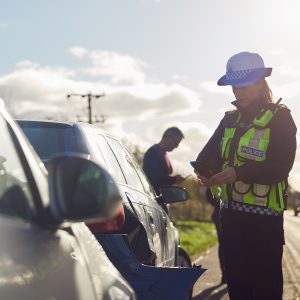Behind the Scenes of the Most Dangerous Job in Law Enforcement: Highway Patrol


In the vast landscape of law enforcement, few roles are as demanding and difficult as that of a highway patrol officer. These brave individuals navigate a world where high speeds, unpredictable conditions, and the relentless traffic flow converge to create a uniquely hazardous environment. Behind the flashing lights and stern expressions lies a profession that requires unwavering dedication, split-second decision-making, and an unyielding commitment to public safety.
The Highway Patrol Mission: Protecting Lives on the Open Road
Highway patrol officers play a pivotal role in safeguarding our roadways. Their mission goes beyond issuing tickets and enforcing traffic laws; it’s about preventing accidents, saving lives, and maintaining order amidst the chaos of the open road. These officers face complex challenges that demand a unique skill set, intense training, and the ability to adapt in high-pressure situations.
Rigorous Training: Preparing for the Unpredictable
Before donning the uniform and hitting the highway, aspiring patrol officers undergo rigorous training covering various scenarios. From pursuit driving techniques to responding to emergencies, their training equips them with the skills to handle the challenges they may encounter. Simulation exercises replicate real-life scenarios, allowing trainees to develop quick reflexes and sound judgment.
The Perils of High-Speed Pursuits
Engaging in high-speed pursuits is one of the most difficult aspects of a highway patrol officer’s job. When a fleeing suspect races down the highway, officers must decide whether to pursue, considering factors such as the risk to innocent bystanders, weather conditions, and the severity of the crime. These decisions must be made in the blink of an eye, often while hurtling down the road at speeds that exceed 100 miles per hour. The delicate balance between apprehending a criminal and ensuring public safety is a constant challenge.
Facing the Elements: Weather and Traffic Conditions
Highway patrol officers brave the elements, rain or shine, day or night. Inclement weather can create treacherous conditions, reducing visibility and causing roadways to become hazardous. Navigating these conditions requires heightened concentration and adaptability. Additionally, the flow of traffic itself presents a significant danger. Officers are frequently exposed to the risk of being struck by passing vehicles, particularly during traffic stops or when assisting stranded motorists.
The Psychological Toll: Managing Stress and Trauma
While the physical dangers are evident, the psychological toll of the job is often overlooked. Highway patrol officers witness horrific accidents and are first on the scene to provide aid. The emotional weight of these experiences can lead to post-traumatic stress disorder (PTSD) and other mental health challenges. Law enforcement agencies are increasingly recognizing the importance of providing officers with resources for coping with trauma and stress, including access to counseling and peer support.
Technological Advancements: Enhancing Safety and Efficiency
As technology advances, so do the tools available to highway patrol officers. Modern patrol cars are equipped with state-of-the-art communication systems, enabling officers to receive real-time updates and coordinate responses effectively. High-definition dash and body cameras capture crucial evidence and provide transparency in interactions with the public. Furthermore, drones are becoming essential tools for surveying accident scenes and assessing traffic congestion from above.
Community Engagement and Education
Highway patrol officers are not only enforcers of the law but also community advocates. They engage in educational initiatives, teaching safe driving practices in schools and community events. Through these efforts, officers aim to prevent accidents before they happen, emphasizing the importance of responsible driving and adherence to traffic laws.
The Thin Line Between Life and Duty
Every day, highway patrol officers face the reality that their commitment to public safety might put their lives on the line. The dangers they encounter are not confined to the highways; they extend to the very nature of their profession. These officers have families, friends, and dreams, but they willingly step into their patrol cars, knowing they are the thin line between order and chaos on the open road.
Behind the iconic uniform and the flashing lights lies a world of sacrifice, bravery, and service. Highway patrol officers represent the unseen heroes who protect our highways, often at great personal risk. Their dedication to protecting lives, maintaining order, and upholding the law is a testament to their unwavering commitment. As we navigate the vast expanse of our highways, let us remember the countless men and women who work tirelessly behind the scenes, making the most dangerous job in law enforcement a beacon of safety for us all.
